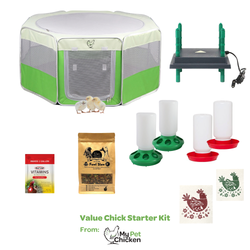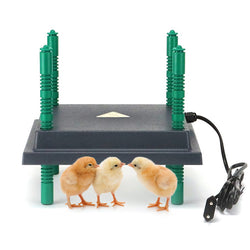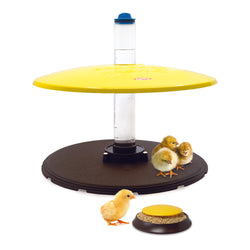Feather Sexing: Why it Won't Work
Back to blog
Going to the feed store with my daughter to see the chicks in the spring is a favorite past time with her. Occasionally, we see a new breeds we're interested in taking home with us. The signage often contains vital information about the chicks that help us decide which to take home. To us these details hold familiarity, but for some people these terms can be confusing and bear some explaining.
Here are the terms you'll see when looking for your chicks and what they mean:
- Pullets: Young females sexed by the hatchery, can be 1 day old to under 1 year to use this term.
- Mixed Pullets: Females of different breeds, including hybrids sexed by the hatchery
- Straight Run: Unsexed chicks including a mix of males and females. These were never sexed by a professional.
- Cockerels: Young males sexed by the hatchery. Ages from 1 day old to under 1 year use this term.
Your local feed store will have chicks available to you based on these choices. They receive them from hatcheries around the country. Some shops will get it whatever is available at the time they order. Breeds and sexing choices can change on a week to week basis due to availability. Last spring we were looking at a bin of straight run Wyandottes that just came in that morning. They were about a week old at the time. A farm retiree that liked to sit up there on warm mornings and chat with the customers started picking up chicks and looking at their wing feathers, then showing why he thought this one was a female or that one was male. He expounded about how he used to hatch thousands of chicks every year, and how he knew which ones were of value to him for their eggs and which ones he would later put into his freezer. In the end I didn't take home those chicks.... but I can fill you in about why you can't rely on methods like these at the feed store. Feed stores get their chicks from hatcheries. Hatcheries typically use vent sexing (not feather sexing) to tell males from females in most breeds. Vent sexing typically provides great accuracy, 95% or more, and the chicks come with a sexing guarantee. Most hatcheries provide a 90% accuracy guarantee, meaning that if more than 10% of their chicks are sexed incorrectly, they'll refund for the mis-sexed birds. (My Pet Chicken is so awesome that we guarantee 100% accuracy: My Pet Chicken Guarantees ) But feather sexing is different--and while it's possible that old farmer was successful with his birds, he could not have been successful with those at the feed store. Why? Well, that type of feather sexing is only applicable to very specific breeds--and even then, it's only applicable in certain strains of those breeds that are specifically selected for feather sexing. And even if you have that specific breed and specific strain, you really need to feather sex at Day 1, not Day 7. Scientifically speaking, some birds can be sexed by the speed of feather growth because they carry the k gene. You'd think this would be a huge break-through... until you realize the problems associated with it. First of all, the gene can be selected for in varieties of birds that have other, way more obvious sex-linked characteristics, so in many cases selecting for the feather growth sexing characteristic is just redundant. (For instance, the k gene could be selected for in sex-linked varieties where the males and females already hatch in completely different colors or patterns; obviously, there is no need to depend on feather growth rate for sexing purposes.) But secondly, you probably don't want k gene birds for your backyard flock. Not only are the genes for the slow feather growth associated with a vulnerability to lymphoid leucosis (a fatal liver disease chickens can suffer from), they also cause increased cannibalism, and can even be a cause of reduced egg production. Here is an except from Mississippi State University Flock Management Page on Sexing Day Old Chicks: "Feather sexing is based on feather characteristics that differ between male and female chicks. The method is very easy to learn by the poultryman, but the feather appearances are determined by specially selected genetic traits that must be present in the chick strain. Most strains (breeds) of chickens do not have these feather sexing characteristics and feathering of both sexes appear identical." This past year I ordered straight run chicks.
You have a 50% chance of being right, based on those feathers. Feather growth is different between breeds, and even in birds of the same breed with different parental genetics. As I found out, feather sexing didn't do me a lot of good. Chances are, the chicks you're getting for your backyard flock just don't have the genetic make up to have this method work. Flip a coin---that method would work just as well as trying to feather sex in this context! My dear old farming friend still sits up our feed store on occasion and makes himself available to dish out advice to anyone who is willing to listen. I sure do enjoy his animated stories, and his classic farming notions... but I still don't let him pick out our chicks.



